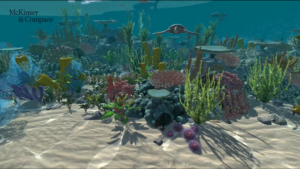
Avoid These Common Mistakes in the McKinsey Problem-Solving Game (PSG)
Avoid These Common Mistakes in the McKinsey Problem-Solving Game (PSG) Facebook Reddit Twitter LinkedIn WhatsApp Table of Contents Brief overview
In the recruitment process of McKinsey, a renowned consulting firm, the McKinsey Problem Solving Game (PSG) has become a crucial assessment tool. This gamified test, also known as McKinsey Imbellus, McKinsey Digital Assessment, and Solve, has replaced the previous assessment called the Problem Solving Test (PST). This comprehensive guide will provide you with a complete understanding of the PSG and offer tips on how to excel in the assessment.
The McKinsey PSG is typically sent to candidates once they successfully pass the initial resume screening, making it the second stage in the hiring process. Candidates participating in the McKinsey PSG are typically required to solve two out of these six mini-games within a total time of 71 minutes, including the time needed to read the instructions. The game not only evaluates your problem-solving abilities but also your time management skills and ability to perform under time constraints.
As of March 2023, reports suggest the Disease, Disaster, and Migration mini-games have become extremely rare, potentially phased out from the PSG. The remaining mini-games continue to assess problem-solving abilities and suitability for consulting roles.
To assess candidates’ problem-solving abilities effectively, the McKinsey Problem Solving Game (PSG) incorporates a comprehensive scoring system that evaluates two key dimensions:
1. Product Score: Evaluating the Quality of the Outcome
The Product Score measures the quality of candidates’ outcomes in the PSG. It assesses if candidates successfully “win” the games by creating a sustainable ecosystem and protecting the plant. This score reflects the overall success of candidates’ solutions, indicating their ability to provide effective resolutions to complex problems.
2. Process Score: Assessing the Approach to Reaching the Outcome
The Process Score evaluates candidates’ approach to achieving the desired outcome in the PSG. It considers every click made by candidates and other variables to understand their decision-making process. Factors like nervousness and execution of a rational plan are taken into account.
By analyzing the Product Score and Process Score, McKinsey gains insights into candidates’ problem-solving abilities, creativity, adaptability, and analytical thinking. These scores help assess candidates’ suitability for consulting roles, where exceptional problem-solving skills are vital.
The McKinsey PSG evaluates candidates’ qualifications and consulting traits, comparing them to those of actual consultants. It measures five key thinking skills:
By assessing these essential skills, the PSG helps identify candidates who possess the necessary competencies to thrive in the demanding world of consulting.
To date, candidates have reported six different scenarios in the McKinsey Problem-Solving Game (PSG). Recent reports from March 2023 indicate that the Disease, Disaster, and Migration mini-games have become exceptionally rare, possibly indicating their gradual removal from the PSG. This breakdown focuses on the three most commonly seen scenarios: Ecosystem Building, Plant Defense and Redrock Study. It also covers Disaster Management, Disease Management, and Migration Management. Strategies and steps are provided for each mini-game to enhance performance.
Objective: Build a self-sustaining natural ecosystem in a coral reef or mountain range.
In this mini-game, you are provided with various animals and plants, each with different nutrient requirements and living conditions. Your task is to select the optimal combination of species and location to create a sustainable ecosystem. Building a food chain of 8 species is necessary to succeed.

Step 1: Select the location
Step 2: Build the food chain
Step 3: Triple-check and adjust
Objective: Protect an endangered plant from incoming invaders.
In this tower-defense-style mini-game, invaders move through a grid, and you must use limited defenders and terrain to prevent them from reaching the plant.
Step 1: Understand the rules and plan your defense
Step 2: Execute defense strategy
Step 3: Optimize your defense and adapt
Objective: Extract information from text, graphs, and tables to answer numerical questions.
This mini-game requires you to play the role of a researcher. You will collect relevant data points from articles, graphs, and tables and use them to answer three quantitative questions. Pay attention to the research process, including investigation, analysis, and reporting stages. Be aware that the format may vary, with phase 2 potentially including additional standalone questions.
Step 1: Investigate and gather relevant data
Step 2: Analyze and answer numerical questions
Step 3: Summarize and visualize data
The McKinsey Problem Solving Game offers a stimulating and immersive experience for individuals aspiring to excel in the consulting industry. By understanding the structure of the game, focusing on key strategies, and practicing problem-solving skills, you can enhance your performance and stand out in consulting case interviews.
Remember, success in the game requires a combination of critical thinking, strategic planning, and adaptability. So, dive in, explore the intricacies of each mini-game, and unlock your full potential as a problem solver in the world of consulting.
Now, get ready to tackle the McKinsey Problem Solving Game head-on and embark on an exciting journey of discovery and growth.

Avoid These Common Mistakes in the McKinsey Problem-Solving Game (PSG) Facebook Reddit Twitter LinkedIn WhatsApp Table of Contents Brief overview

This article aims to provide you with valuable tips and strategies to help you master the Ecosystem Building game and

In the realm of job assessments and recruitment, McKinsey & Company, a renowned global management consulting firm, has introduced an